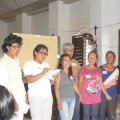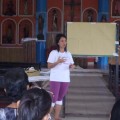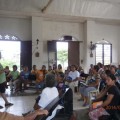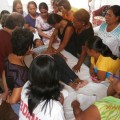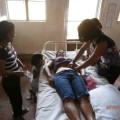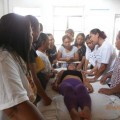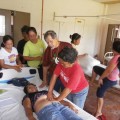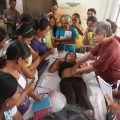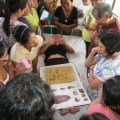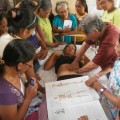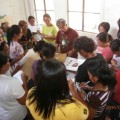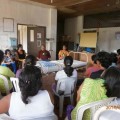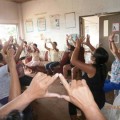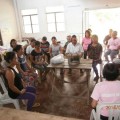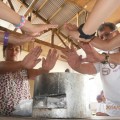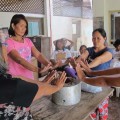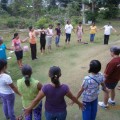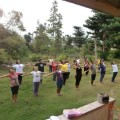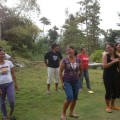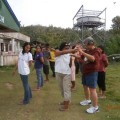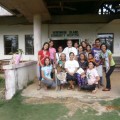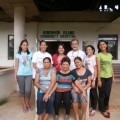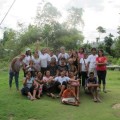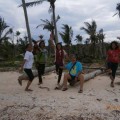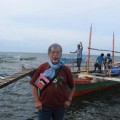We thought we could not leave Manila because there was a typhoon in the horizon, but we took the plane to Tacloban City anyway. We were picked up at the airport and brought to Guiuan, Samar 3 hours east. Along the way, I noticed reconstruction work. It was different from the last time we did a mission in February 2014. The tent city along the way was gone. The coconuts had grown leaves and a few fruits, a sign of hope and recovery. We slept over and in the morning we — Melody, Gecil, Emile (all from PMPI national secretariat, the sponsor of the mission), Lotlot, Annie and I ( from INAM PHILIPPINES) — were ferried in a small open lan-tsa, a catamaran pump boat, to Homonhon, Ferdinand Magellan’s first landfall in the Philippines before he proceeded to Cebu and Mactan where the explorer was slain in a battle.*
It was windy and the sea was rough (maalon in Tagalog). We all got soaked during the 3-hour ride. We stayed at the parish house of the Roman Catholic Church in Barangay Casuguran. That night the storm broke and dropped tons of water on the iron roof as the wind whistled through the night. I woke up and listened. Finally I fell asleep and I woke up to dogs barking and roosters crowing. We had a great weather the rest of our stay on the island.
The healing mission to Homonhon was part of the closure activity of what was called Early Recovery Phase that included relief and immediate response (after typhoon Haiyan/Yolanda) of Project Pagbangon initiated by the Misereor of Germany and the Philippine Misereor Partnership, Inc. Our group was going to provide training to leaders, midwives and barangay health workers massage training as a continuation of INAM TaoRen Terapi for trauma and wellness that we conducted in in Guiuan, Victory Island and Tacloban City February 2014. The Integrative Medicine for Alternative Health Care Systems (INAM) Philippines that I belong to as a consultant and trainer is one of the PMPI network members that are responding to the health issues of the island.
We had a seminar for more than 20 women from different barangays. There were 7 – 8 men on the first day but they were all called to a meeting on another initiative relief program of PMPI.
In my introductory remarks, I said that it is important to learn the techniques not only for trauma but also to make them a part of our culture and life, that the healing tradition of the Philippines as represented by the ancient healer and priestess called babaylan has to be revived, and that each person in the spirit of self-reliance and autonomy, could be a healer in her own way.
We started the training at the church with Jade Mountain CNT (Chi Nei Tsang) organs massage. JMCNT is my own version of organs
massage developed by the Healing Tao master Mantak Chia in the mid-80s. I was one of the senior instructors who wrote and edited the book that is now a classic in the New Age literature. The techniques involved manipulations on the different organs – Liver, Kidneys, Stomach, Colon, Lungs, Heart. In Chinese medicine, these organs hold emotions – anger, fear, worry and anxiety, grief and sadness – and manifest different illnesses as a result. Especially in cases of severe traumas, these emotions could sit in the organs for a long time and affect the physical and mental balance of a person unless a multi-faceted healing approach is implemented. Unlike ordinary massage on the muscles, JMCNT goes direct to the source of the problems, the organs themselves.
Since we needed tables, we moved to the local community health center. At first, I wondered how the participants would react to this style of bodywork because the patient has to expose the abdomen in the course of the treatment. I know from years of teaching in different countries that women in certain cultures are averse to or are not allowed to show certain parts of the body like the abdomen or, in a worst case scenario, even the face. The organ massage was something new to everybody. I demonstrated the first technique, a manipulation on the stomach with Lotlot, my assistant, as the model patient. She was a very funny and ooperative patient, so she was a good example for others to follow.
The participants were surprised to hear that certain shapes of the navel could reflect chronic or lifetime obsessions and emotions, that an experienced practitioner of Chinese and Japanese palpatory diagnosis could actually “read” what it “says.” I told them that in certain countries where women are repressed, the navels are often closed.
There was much laughter as we broke into 5 groups, each one practicing the technique that was demonstrated.
In the course of the 2 and ½ days we also covered 6 Healing Sounds, an ancient Chinese qigong method that deals with emotions and energy; several movements of Xing Shen ZhuangFa, another qigong tradition that focuses on strengthening the spine; DragonWell Qigong, my synthesis of several Buddhist and Daoist techniques; and Power Animals (Tiger, Dragon, Crane, Snake). I told the group each animal represents a different virtue and power. I said I’ll teach them the monkey next time!
At the end of 3 days we had a Fire Ritual in front of a burning clay kalan/cauldron for closure. Fire is one of the alchemical elements for transformation in ancient cultures. The other is Water. I gave an empowerment and protection, a Daoist form of blessing, to each and every one of the participants.
It was an exhausting procedure for me, partly because of the individual qi work but also because I had almost no sleep for a week. I flew from Newark Airport on Thursday morning, arrived at NAIA on Friday night and proceeded to Tacloban City that Saturday.
All 6 of us had a long walk on the beach and watched the sunset beyond the mountains when the training was finished. Emile, the local facilitator and Melody, the Project Officer of PMPI, brought us San Miguel beer and we sat and listened to the night wind and the tides in the dark. We talked about our work and the effects of training that we had just conducted in Homonhon. We wondered how much of what we taught would become a part of the culture of healing and self-cultivation in the local community.
When we left the island to return to Guiuan the next morning, the sea was calm and smooth. To me, it was a sign of good things to come. We were tired but happy we were able to share the different techniques of healing and recovery and bring laughter to the women and one boy from the barangays.
*There is a conflict of opinions about whether Homonhon is the first or the second landfall of Ferdinand Magellan. According to Vicente C. de Jesus, “ The popular belief, based on Antonio Pigafetta, is it’s Homonhon. Francisco Albo’s Logbook states the fleet anchored first at Suluan Island.”
